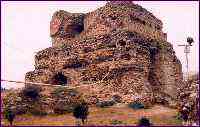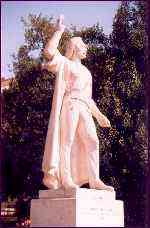The historical past of Serres
| T |
It is mentioned for the first time in the early fifth century BC by Herodotus as Siris and its citizens as Siropaeons of the Paeonian nation, even though the town was founded much earlier, (est. 13-12 century BC). Serres was already the chief town of its district in the time of Herodotus.
The oldest surviving monument which preserves the inscription "Sirraion Polis" (city of citizens of Serres) dates in the Roman period and is exhibited in the Archaeological Museum of Serres. From the 5th century AD the city is mentioned by today's name, Serres. The name Siris (and later Serres) may be derived from the word sirios=helios (which means sun).
In the course of the 5th century, the city of Serres was mentioned as the seat of a Bishop while in the early 6th century it was the most important city of the 7th province of the Byzantine state. From the 8th century on Serres has played a leading role in Greek history and considered to be the most important among the cities between the rivers Nestos and Strymon. The Byzantine authors called it "great and wonderful city", "powerful", "essential", "good", "rich", "greatest", "guarded by God" and so on.
During the Middle ages it had been often hard hit, sometimes even completely destroyed. It should be mentioned that Serres has thus been in jeopardy several times, but managed to survive. It was ravaged in 1195-96 by the Bulgarians who defeated a Byzantine army and took prisoner Isaac Comnenus, the sebastocrator. In the autumn of 1204 it surrendered to the Franks crusaders, who set out to free the Holy Land and ended up by enslaving a Christian state.
In 1205 the Bulgarian ruler John I, seized Serres, captured the Franks garrison Hugues de Coligny and completely sacked the city. In 1221 the city fell into the hands of the Despot of Epirus, Theodoros, but in 1230 in the battle of Klokonica the Bulgarian ruler John II captured and blinded Theodoros and seized Serres. After a sudden attack in 1245, the Bulgarian commander Dragotas had to surrender the city to John Batatzes, Emperor of Nicaea. Boniface de Monferrat, hastening from the Morea, recaptured and fortified the town.
 It resisted the attacks of Cantacuzenus following a long siege , in 1345
Stephen Dushan, ruler of Serbia, seized Serres. In Serres Dushan promulgated
his legal code. Helen, his wife, retired here under the religious name of Elizabeth.
In the meanwhile Greeks managed to capture Constantinople. The fortified
ancient remnants of Acropolis as well as those of the main tower, are the remains
of the Serbian occupation. The inscription on the main tower of the citadel
"������� � �������" (which means built by Orestis) indicates that it was
built by Orestis, a well-known general judge and leader of the army.
It resisted the attacks of Cantacuzenus following a long siege , in 1345
Stephen Dushan, ruler of Serbia, seized Serres. In Serres Dushan promulgated
his legal code. Helen, his wife, retired here under the religious name of Elizabeth.
In the meanwhile Greeks managed to capture Constantinople. The fortified
ancient remnants of Acropolis as well as those of the main tower, are the remains
of the Serbian occupation. The inscription on the main tower of the citadel
"������� � �������" (which means built by Orestis) indicates that it was
built by Orestis, a well-known general judge and leader of the army.
Following the Serbs' defeat by the Turks at Tzernomiano (Evros river in 1371), the Serb tiny administrative district of Serres was dissolved and its capital, Serres, was taken over by the King of Thessaloniki Emmanuel II. However, it was not meant to remain in Greek hands for a long period. The city was temporary conquered by the Turks in 1373 and it fell decisively to them in 1383, seventy years before the fall of Costantinople.
At the time of the Turkish conquest, the city boundaries were immensely extended. At the beginning of 1600's the Turkish writer Hadji Calfa, called Serres the "city of the sages", while his compatriot Elviya Tselebi, mentioned Serres at the 1668, as the third greatest city in size and importance of European Turkey.
The same period of time, the enlightened years in Europe, science and letters in Serres were intensely cultivated. Through those schools, a plethora of bright minds paraded over the years. The college of Education in Serres was the first that was founded in the whole European Turkey in 1672 and the teachers who graduated from it, spread far beyond Greece and turned out to be a vital force in the education and cultural awakening of the Greek nation. Furthermore several were the benefactor of Serres who contributed to the founding and the upkeep of those schools.
During the final stages of the Turkish rule, when railroads were non-existent, the pirates dominated the seas and goods were transported in caravans, the golden plain of Serres and its endless riches of cereals and cattle-breeding products, led to the city's enjoying great success as a mercantile center. Serres become a famous distribution center for goods, attracting merchants and buyers from all over the world. Its enormous fame was closely linked with the textiles, cotton, horses, buffaloes, and finely crafted earthenware vessels.
 The citizens of Serres took part in all the pre-Revolutionary movements
of the subjected Greeks during the astonishingly prolonged slavery and paid
dearly for their deep love of freedom. The revolution of 1821 brought
distinction to some heroic figures such as Emmanouel Papas, whose whole
family suffer a tragic fate, as well as to the writer of the revolutionary
movement Nicolaos Kasomoulis.
The citizens of Serres took part in all the pre-Revolutionary movements
of the subjected Greeks during the astonishingly prolonged slavery and paid
dearly for their deep love of freedom. The revolution of 1821 brought
distinction to some heroic figures such as Emmanouel Papas, whose whole
family suffer a tragic fate, as well as to the writer of the revolutionary
movement Nicolaos Kasomoulis.
Throughout the Macedonian Struggle (1904-1908), Serres alongside the city of Thessaloniki and Monastiri, played a major role in organising and leading the Struggle. At the end of the second Balkan War, a big part of Serres was burned and ruined by the retreating Bulgarians. The bells of freedom sounded at last after 530 years of slavery. Serres' greatest moment had arrived. It was at this juncture that the 7th Greek Brigade entered the distressed city. The brigade commander, Napoleon Sotillis, through the proclamation of 28th June of 1913 announced that "...from that day forth, he liberates and occupies the city and invites his citizens, regardless of race, language and religion, to return to their peaceful occupations".
During the Second World War, the citizens of Serres took part in Roupel's fight, among the boundaries with Bulgaria, and managed to delay Hitler's army for a week (6-13 April 1941) besides the enormous size of the Nazists' armies. Roupel's fort was never seized, but when German soldiers get round Roupel, occupied without any resistance Yugoslavia and conquered Thessaloniki and Athens, the heroic soldiers of Roupel were ordered by the Greek government to stop the fight and give fort's lead to Germans. It is to be noticed that the Greek sergeant who was the leader of Greek army in the fort, preferred suicide to be surrendered by Germans. When the Greek soldiers were getting out of the fort, Germans congratulated them, by presenting their guns, which is the highest honour in the German army.
This page is maintained by Panagiotis G. Ipeirotis ([email protected]) .